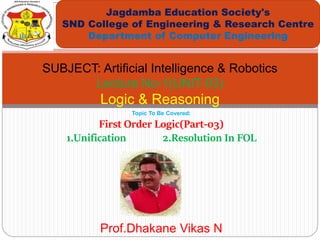
Ai lecture 11(unit03)
- 1. Topic To Be Covered: First Order Logic(Part-03) 1.Unification 2.Resolution In FOL Jagdamba Education Society's SND College of Engineering & Research Centre Department of Computer Engineering SUBJECT: Artificial Intelligence & Robotics Lecture No-1(UNIT-03) Logic & Reasoning Prof.Dhakane Vikas N
- 2. What is Unification Unification Unification is a process of making two different logical atomic expressions identical by finding a substitution. Unification depends on the substitution process. It takes two literals as input and makes them identical using substitution.
- 3. What is Unification Unification :Conditions for Unification: Following are some basic conditions for unification: 1. Predicate symbol must be same, atoms or expression with different predicate symbol can never be unified. 2. Number of Arguments in both expressions must be identical. 3. Unification will fail if there are two similar variables present in the same expression.
- 4. What is Unification Unification :Example E.g. Let's say there are two different expressions, P(x, y), and P(a, f(z)). In this example, we need to make both above statements identical to each other. For this, we will perform the substitution. P(x, y)......... (i) P(a, f(z))......... (ii) Substitute x with a, and y with f(z) in the first expression, and it will be represented as a/x and f(z)/y. With both the substitutions, the first expression will be identical to the second expression and the substitution set will be: [a/x, f(z)/y].
- 5. What is Unification Unification :Example We can resolve two clauses which are given below: [Animal (g(x) V Loves (f(x), x)] and [¬ Loves(a, b) V ¬Kills(a, b)] Where two complimentary literals are: Loves (f(x), x) and ¬ Loves (a, b) These literals can be unified with unifier : [a/f(x), and b/x] , and it
- 6. What is Unification(Unification :Algorithm)
- 7. Resolution in FOL Resolution in FOL Resolution is a theorem proving technique that proceeds by building refutation proofs, i.e., proofs by contradictions. It was invented by a Mathematician John Alan Robinson in the year 1965. Resolution is used, if there are various statements are given, and we need to prove a conclusion of those statements. Unification is a key concept in proofs by resolutions. Resolution is a single inference rule which can efficiently operate on the conjunctive normal form or clausal form.
- 8. Resolution in FOL Resolution in FOL Clause: Disjunction of literals (an atomic sentence) is called a clause. It is also known as a unit clause. Conjunctive Normal Form: A sentence represented as a conjunction of clauses is said to be conjunctive normal form or CNF. Example: We can resolve two clauses which are given below: [Animal (g(x) V Loves (f(x), x)] and [¬ Loves(a, b) V ¬Kills(a, b)] Where two complimentary literals are: Loves (f(x), x) and ¬ Loves (a, b) These literals can be unified with unifier θ= [a/f(x), and b/x] , and it will generate a resolvent clause: [Animal (g(x) V ¬ Kills(f(x), x)].
- 9. Resolution in FOL Resolution in FOL Steps for Resolution: 1. Conversion of facts into first-order logic. 2. Convert FOL statements into CNF 3. Negate the statement which needs to prove (proof by contradiction) 4. Draw resolution graph (unification). To better understand all the above steps, we will take an example in which we will apply resolution.
- 10. Resolution in FOL Resolution in FOL Steps for Resolution: Convert FOL statements into CNF
